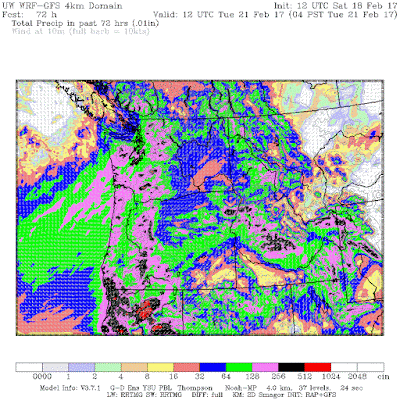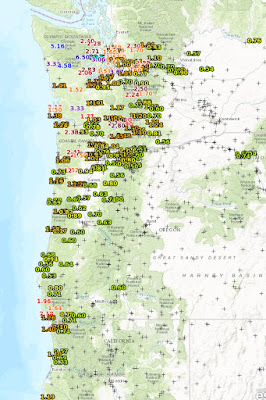THUNDERSNOW HAS HIT SEATTLE!
As predicted, a strong convergence zone has formed over Puget Sound, producing heavy precipitation and lightning (see radar at 3:30 PM)
The heavy precipitation is driving the freezing/snow levels towards the surface and there is mixed rain/snow here at the UW. Did you notice how the snow was associated with the heaviest precipitation?
Lightning even hit the Space Needle (see below)
Hopefully, the lightning won't get near the overturned truck on I5 loaded with butane....
____________________
It was quite a surprise for many as heavy snow started falling in Seattle around 6:30 AM this morning. The National Weather Service did talk about the potential for rain and snow showers, but the this morning the snow was quite substantial with .5-2.5 inches around Seattle and neighboring communities.
What happened?
An area of particularly heavy precipitation that pushed the snow level to sea level.
When I went out to get the newspaper at 6:30 AM it was actually raining, but as the precipitation intensity increased, snow started mixing in, followed by big wet flakes.
The Camano Island radar shows the culprit (see below): a small area of heavy showers (yellow is moderate intensities). The precipitation is being enhanced over central Puget Sound due to convergence (air coming together) in the lee of the Olympic Mountains (a weak Puget Sound Convergence Zone).
The freezing level at 5:30 AM was at roughly 1300 ft, but near-freezing temperatures were found down to around 500 ft. As a rule of thumb, the snow level (the level at which all snow from aloft melts) is roughly 1000 ft below the freezing level. So we were close,
As the snow aloft melted, it cooled the air below (it takes heat to melt the snow!), causing the freezing and snow level to be pushed lower. The descending snow level quickly reached the surface, resulting in snow accumulating on grass, building, and even the roads (which were above freezing). Beautiful big flakes.
Why were the snowflakes so big? Because at marginal temperatures at or near freezing snowflakes are more "sticky" and they tend to form large aggregates of smaller snowflakes.
Roads should improve and daytime solar heating will ensure that temperatures rise by early afternoon. But there are some more showers moving in that could cause some snow showers. And there is another chance of significant snow later this afternoon as a Puget Sound Convergence Zone forms north of the city (see snowfall forecast for the 3-hr ending 4 PM). This graphic shows where snow is expected (green/blue colors) and rainfall (gray shades). Only where the intensities (and thus cooling due to melting) is there snow. Where light precipitation exists, there is rain.
___________________
The Northwest Weather Workshop
And don't forget...if you want to attend the big weather meeting of the year...the Northwest Weather Workshop on March 3-4 in Seattle...you have to register before. The agenda and more information (including how to register) is found here: https://www.atmos.washington.edu/pnww/

























































